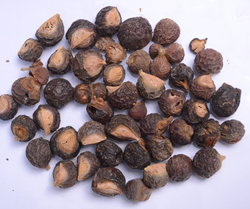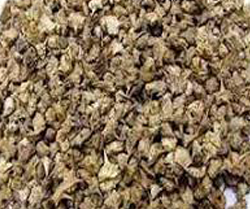- Email: sales@malharenterprises.net.in
- Phone: +91 9004684904
FRUITS
- Home / Fruits
Fruits
Amla/Phyllanthus emblica
Sanskrit : Amla, AmalakiEnglish name : Indian Gooseberry,Emblic Myrobalan Tree
Cultivation : It is planted through the deciduous of tropical India and is commercially cultivated in the state of Uttar Pradesh in India. It is also grown in Tamil Nadu,Rajasthan and Madhya Pradesh also.
Medicinal Uses : The fruit is the richest source of Vitamin C and is a diuretic, aperient, Laxative and hair dye. It cures insomnia and is healthy for hair. It is used as the cardio protective,useful in hemorrhage, menprrhagia, leucorrhoea and discharge of blood from uterus.

Neem/Azadirachta indica
Sanskrit : Arishta, nimba, minbakaEnglish name : Neem, Indian Lilac,nim, crackjack, paradise tree,chinaberry
Cultivation :It is native to India, Myanmar, Bangladesh, Sri Lanka, Malaysia and Pakistan. It grows in tropical and semi-tropical regions.
Medicinal Uses : Neem leaf is used for leprosy, eye disorders, bloody nose, intestinal worms, stomach upset, loss of appetite, skin ulcers, diseases of the heart and blood vessels (cardiovascular disease), fever, diabetes, gum disease (gingivitis), and liver problems. The leaf is also used for birth control and to cause abortions.

Aritha / Sapindus Mukorossi
Sanskrit :Ritha, Reetha, Aritha, Dodan, Doadni, Doda,English name : Soap Nut
Medicinal Uses : The fruit is collected during winter months for seed and or sale in the market as soap nut. The dried fruit of Ritha is most valuable part of the plant. Its fleshy portion contains saponin, which is a good substitute for washing soap and is as such used in preparation of quality shampoos, detergents, etc. In fact the skin of the fruit is highly valued by the rural folks as a natural produced shampoo for washing their hair. They also use these for washing woolen clothes.

Bheda / Bergenia Ligulata
Sanskrit :Asmabhedaka, SilabhedaEnglish name : Winter Begonia
Medicinal Uses : Pashanbheda is used in Ayurveda and Unani system of medicine for treatment of many diseases especially for urinary stones. The plant roots has cooling, laxative, analgesic, abortifacient (abortion causing) and aphrodisiac properties. The roots are used in the treatment of vesicular calculi, urinary discharges, excessive uterine haemorrhage, diseases of the bladder, dysentery, menorrhagia, splenic enlargement and heart diseases. Ayurveda mentions, the roots as bitter, acrid, post digestion pungent and cool in potency. It is tridoshnashak (balances Vata, Pitta, and Kapha).
Gokharu / Tribulus Terrestris
Sanskrit :Gokshuraka, Trikata, Svadamshtra, TraikantakaEnglish name :Caltrops, Puncture vine
Medicinal Uses : The whole plant of gokharu is used in the form decoction and powder to treat consumption,calculi,intrinsic hemmorrhage,dysuria to promote hair-growth,arthritis rejuvenative and as an aphrodisiac.

Harde / Terminalia Chebula
Sanskrit :HirdaEnglish name :Indian walnut, Indian hog plum
Medicinal Uses : The fruit of haritaki is used in the form powder to treat fever diarrhoea,lack of appetite indigestion,piles,intrinsic haemorrhage,vomting,cough,hiccough,asthma ,anaemia,aundice,enlargement of liver and spleen,oedema,skin diseases,obestiy,daibetes,narcosi s and fainting,scrotal enlargement inguinal

Himej / Terminalia Chebula
Sanskrit :HaritakiEnglish name : Himej
Medicinal Uses : Himej is very well-liked, traditional and trendy herb used since ancient time. In ayurveda, it is known as ‘herb to increase life’. It has effect of rejuvenation on body. It is found abundantly in Asia. It is fruits are seem as nut and used to made many medicines along with other herbs.According to ayurveda, himej is life increasing herb. It balances all three ‘dosha’ of body by increasing fire of digestion, it cleanup whole system of digestion and restores proper digestion.

